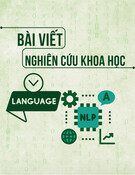
VĂN HÓA https://jst-haui.vn Tạp chí Khoa học và Công nghệ Trường Đại học Công nghiệp Hà Nội Tập 60 - Số 12 (12/2024)
70
NGÔN NG
Ữ
P
-
ISSN 1859
-
3585
E
-
ISSN 2615
-
961
9
EXPLORING THE BENEFITS AND CHALLENGES OF SELF-RECORDING VIDEO TASKS IN ENHANCING ENGLISH-SPEAKING SKILLS: PERSPECTIVES FROM EOP STUDENTS
GÓC NHÌN CỦA SINH VIÊN HỌC TIẾNG ANH THEO ĐỊNH HƯỚNG NGHỀ NGHIỆP VỀ LỢI ÍCH VÀ KHÓ KHĂN KHI THỰC HIỆN QUAY VIDEO NHẰM NÂNG CAO KỸ NĂNG NÓI Tran Kieu Anh1,*, Nguyen Thi Loan1, Dinh Thi Bich Nguyet2 DOI: http://doi.org/10.57001/huih5804.2024.419 ABSTRACT Technology innovation has greatly affected language learning and teaching. One of the beneficial applications is the utilization of self-
recording videos
(SRV) to boost EFL learners’ speaking skills. At School of Languages and Tourism (SLT) - Hanoi Univers
ity of Industry (HaUI) in Vietnam, along with the
introduction of a blended learning approach, SRV has been employed as a method for students to improve their speaking skills. However, previous research
has
not explored the perspectives of these students on SRV at the School of Languages and Tourism, HaUI. Hence, this study aims t
o explore the perspectives of
English for Occupational Purposes students from HaUI on the utilization of SRV to develop their o
ral performances in English. Data was collected from 148
students majoring in Chemical Engineering at SLT, HaUI through an online questionnaire adapted from Encalada and Sarmiento [1]
. The results indicated that
though the majority of the respondents had positive perceptions towards SRV tasks, some constructive feedback and suggestions
related to peer and teacher
feedback were offered to ensure the effectiveness of the activity. Those
are particularly valuable for the teachers to modify and take full advantage of SRV tasks
on their online learning platform to boost learners’ speaking skills. Keywords: Self-recording videos, speaking skills, perspective, EOP. TÓM TẮT Công nghệ và những thành tựu của nó đã và đang có những ảnh hưởng lớn đến việc dạy và học ngoại ngữ. Việc sinh viên được yêu cầu thực hiện tự
quay
video trong khi học kỹ năng nói là một trong các ứng dụng mang lại hiệu quả đối với việc phát triển kỹ năng này. Tại Trường Ngoại ngữ - Du lịch, Trường Đại họ
c
Công nghiệp Hà Nội, cùng với sự ra đời của phương pháp học kết hợp, với mục đích hỗ trợ sinh viên cải thiện kỹ năng nói, sinh viên được yêu cầu thực hiệ
n ghi
hình lại các bài nói, các bài hội thoại của mình. Tuy nhiên, chưa có nghiên cứu được công bố nào đề cập đến góc nhìn của sinh viên tại Trường Ngoại ngữ - Du lị
ch
về việc thực hiện nhiệm vụ này. Để tìm hiểu về vấn đề này, một khảo sát đã được thực hiện với 148 sinh viên học ngành Kỹ thuật Hoá học học ngoại ngữ tại trườ
ng
Ngoại ngữ - Du lịch. Số liệu được thu thập thông qua bảng câu hỏi trực tuyến dựa trên bảng hỏi của Encalada và Sarmiento [1]. Kết quả chỉ ra rằng, phần lớ
n các
sinh viên tham gia nghiên cứu có đánh giá tích cực với việc thực hiện nhiệm vụ quay video này. Một số đề xuất liên quan tới phản hồi, nhận xét từ giả
ng viên và
các sinh viên khác về video cũng được đưa ra, trở thành cơ sở để giảng viên cân nhắc điều chỉnh, nhằm khai thác triệt để lợi ích mà nhiệm vụ này mang lại. Từ khoá: Quay video, kỹ năng nói, góc nhìn, tiếng Anh định hướng nghề nghiệp. 1School of Languages and Tourism, Hanoi University of Industry, Vietnam 2Faculty of Tourism, Hanoi Open University, Vietnam *Email: kieuanh.haui@gmail.com Received: 05/11/2024 Revised: 15/12/2024 Accepted: 26/12/2024

P-ISSN 1859-3585 E-ISSN 2615-9619 https://jst-haui.vn LANGUAGE - CULTURE Vol. 60 - No. 12 (Dec 2024) HaUI Journal of Science and Technology
71
1. INTRODUCTION English speaking skills should never be underestimated as they play a vital role in helping learners master their daily conversations with foreigners, equipping them with the ability to respond swiftly, and increasing the effectiveness of interactions in any circumstances that require English communication. Possessing excellent speaking skills may also boost an individual’s listening capability since speaking and listening complement each other bilaterally. Those who can speak English fluently hold the key to opening a new chapter in their career development, with a great deal of promising opportunities for overseas trade cooperation and significantly strengthening relationships with global business partners. Brown and Yule [2] expressed the significance of speaking skills as a tool to measure the language qualifications of a student when they face practical situations. Parupalli Srinivas Rao [3] stated that speaking skills are decisive in selecting the most appropriate candidate for a job. With the support and application of advanced technology in studies these days, one of which is self-recorded videos (SRV), learners can approach more effective methods to cultivate their speaking skills. English for Occupational Purposes is a program specifically designed for students at Hanoi University of Industry (HaUI), combining online and face-to-face lessons. The online learning program provides students with vocabulary and grammar tasks under the teachers’ instructions to help them practice all four English skills at home. A noticeable exercise in the online lessons is the speaking video, which will be self-recorded by the students and then assessed by the teachers. Meanwhile, students join various individual, pair, and group activities that require practical interactions among students in the class. These face-to-face tasks are closely associated with the online sessions, aiming to accumulate speaking experiences for learners. The study explores some benefits as well as obstacles that EOP students at HaUI, particularly Chemical Engineering students at SLT, have while doing self-recording video tasks. In addition, suggestions are offered for teachers to optimize the utilization of the task. The following issues were discussed: (1) What benefits do EOP students gain from doing SRV tasks? (2) What challenges do EOP students encounter while doing SRV tasks? (3) What suggestions might be given to enhance the effectiveness of SRV in improving speaking skills? The research consists of the following major sections: research context and literature review, research methods, findings and discussion, and conclusions and suggestions. In order to complete this research, a questionnaire modified from the study by Encalada and Sarmiento [1] was delivered to 148 students online to gather their evaluations, and experiences with SRV tasks. Not only do these data provide new insights into English language teaching, but they also serve as reference materials for teachers to make necessary amendments and enhance the efficiency of SRV to maximize learning outcomes in online sessions. 2. LITERATURE REVIEW 2.1. Self-Recording Technique Self-recording is defined as a project created and recorded by an individual (Fitriyani) [4]. It is regarded as a contemporary teaching method used by creative teachers in language teaching. The use of self-recording, particularly for oral performance in EFL classes, is anticipated to enhance students' confidence in front of the camera and in face-to-face conversations. This medium is also intended to assist students to become more competent speakers. Utilizing video self-recording is a helpful method in educational process that helps EFL students enhance their linguistic skills. Allen [5] defined video self-recording as a “self-directed learning strategy” where learners film themselves discussing various topics. Technological innovations have made it easier for EFL students to use a variety of portable devices including smartphones, laptops, and tablets for this purpose. In universities in Vietnam, most students possess smartphones, this technique is readily accessible for English learning. The benefits of applying this technique are reported by researchers. Savaş [6], states that the self-video technique boosts self-efficacy, increases comfort levels, and enhances English speaking skills through practice. Additionally, a quasi-experimental study by Islam [7] investigated the impact of self-conversation recordings on EFL learners’ oral fluency. The results present that those students who use self-conversation videos improve their fluency and grammatical accuracy, with the control group showing significantly lower fluency achievements compared to the experimental group. In Joko Prayudha's research [8] students show positive attitudes, especially emphasize self-confidence in their English communication. They also become more confident in sharing opinions and expanding their utterance.

VĂN HÓA https://jst-haui.vn Tạp chí Khoa học và Công nghệ Trường Đại học Công nghiệp Hà Nội Tập 60 - Số 12 (12/2024)
72
NGÔN NG
Ữ
P
-
ISSN 1859
-
3585
E
-
ISSN 2615
-
961
9
Arthurson’s findings also prove that making videos enables students to assess both their own performance and that of their peers [9]. Hence, it is apparent that the self-video technique offers an efficient approach to English language learning and teaching by enhancing self-confidence, comfort levels, fluency, and grammatical accuracy 2.2. Mobile-Assisted language learning Mobile learning is explained by Trifonova and Ronchetti [10] as the employment of information technology in improving instructional process through mobile technologies. Thus, mobile-assisted language learning could be described to as the integration of mobile devices to enhance language proficiency. In terms of its advantages, Jeng, Wu, Huang, Tan and Yang [11] suggest that mobile technologies assist and enhance learners’ interactions by allowing access to, discussion of, and sharing of information via social networks. Khan and Islam [12] state that mobile-assisted language learning could sustain learners’ enthusiasm, enhance learners’ involvement, and strengthen their learning motivation. Additionally, mobile-assisted language learning enables learners to communicate with teachers and peers collaboratively, offer feedback and improve language skills. Moreover, mobile-assisted language learning provides learners with opportunities to interact with native speakers. Hashim et al.; Octavia et al. [13, 14] argued that mobile devices make authentic materials more easily approachable compared to traditional teaching methods. The research conducted by De Vega, Basri and Nur [15] examined the effectiveness of the implementation of mobile-assisted language learning in blended learning approach revealed that language learning results, motivation, engagement, and overall satisfaction were substantially enhanced. 3. METHODS The study employed a quantitative research design. The participants were 148 third-year students enrolling in the EOP courses at Hanoi University of Industry. They were chosen for their experience with the program, having completed five English courses and currently taking their sixth. The EOP program's blended learning structure includes 10-week blended learning courses. Each course consists of a total of 2,000 minutes of face-to-face lessons and 1,750 minutes of online lessons (using an internally developed platform). The target of offline lessons is on speaking skills, while online lessons focus on vocabulary, grammar, listening, and writing. Students are required to upload at least one self-recording video per unit, addressing specific topics or enacting scenarios (about one video per week). Teachers provide feedback and grades on two or three videos per student, which contribute to the final course grade. The teacher is the one who decides which videos and when to grade. The criteria for marking are detailed and specific for the teachers to follow. Students are introduced to the criteria and then have them explained and clarified at the beginning of each semester. A self-administered online questionnaire was developed and delivered via Google Forms. The questionnaire included of two main sections: • Section 1: This section presented 5 Likert-scale multiple-choice questions designed to determine student perceptions of the usefulness and effectiveness of self-recording video tasks for enhancing speaking skills. • Section 2: This section included six options that allowed students to choose any features they believed should be improved based on their own experiences with self-recording video tasks for better implementation of the activity. The data was then input into Excel to be analyzed. The results were demonstrated in the table and a bar chart for interpretation and discussion. 4. FINDINGS AND DISCUSSIONS 4.1. Linguistic benefits versus Non-linguistic benefits The provided data offers better understanding of the benefits of SRV in language learning from EOP students’ viewpoint. The results indicate a strong positive perception of this technique across various linguistic and non-linguistic domains. Table 1. Linguistic benefits of self-recording videos Strongly disagree
Disagree
Neutral
Agree
Strongly agree Developing students’ English pronunciation 1.3% 5.4% 28.0% 32.0% 33.3% Strengthening students’ lexicon and grammatical knowledge 2.7% 4.1% 18.2% 62.8% 12.2%

P-ISSN 1859-3585 E-ISSN 2615-9619 https://jst-haui.vn LANGUAGE - CULTURE Vol. 60 - No. 12 (Dec 2024) HaUI Journal of Science and Technology
73
Providing
authentic scenarios
for practice 2.0% 8.8% 21.6% 39.9% 27.7% Linguistics-related benefits Developing students' English pronunciation A notable 65.3% of participants showed their agreement with the idea that the process of SRV greatly enhances their English pronunciation. This high percentage reflects a strong supportive opinion from the students. This aligns with previous research by Derwing and Munro [16] who found that by providing opportunities for self-monitoring and repetition, SRV can facilitate the acquisition of target language sounds and intonation patterns. Strengthening students' lexicon and grammatical knowledge Similarly, the data shows that 62.8% of students strongly agreed that SRV boosted lexical and grammatical competence. SRV require learners to activate a variety of lexical items and grammatical structures, and promote language production and consolidation. This finding supports the study by Menggo Suastra and Padmadewi N. N. [17] which concluded that SRV significantly enhance students' academic English-speaking competence, including grammar. Providing authentic scenarios for practice Furthermore, almost all participants (over 60%) strongly agreed or agreed that SRV offered authentic practice opportunities. By simulating real-life communication situations, SRV can enhance learners' communicative competence and intercultural awareness. This is consistent with research by Shen [18] which discussed how SRV provide authentic scenarios for students. This approach allowed students to participate in lifelike and applicable practice situations, enhancing their learning experience and performance in high-fidelity simulations. Non-linguistic benefits Table 2. Non-linguistic benefits of self-recording videos Strongly disagree
Disagree
Neutral
Agree
Strongly agree Improving students’ non-verbal expressions
3.4% 5.4% 15.5% 39.9% 35.8% Developing students’ collaborative learning with conversations 2.0% 3.4% 12.8% 31.1% 50.7% Increasing students’ self-confidence 2.0% 4.7% 8.1% 76.4% 8.8% While linguistic gains are evident, the data also underscores the non-language skills developed through self-recording. Improving students' non-verbal expressions The result suggests students’ non-verbal expressions were being enhanced gradually through self-recording video tasks (39.2% strongly agree, 39.9% agree). By practicing and reviewing their own body language and facial expressions, learners can improve their overall communicative skills. This finding is in accordance with research by Encalada M. A. R. and Sarmiento [1] which emphasizes the importance of nonverbal communication in effective language use. It is noted that through self-recording tasks, students were able to observe and improve their body language, facial expressions, and gestures, which are essential elements of successful communication in a second language. Developing students' collaborative learning with conversations There is a strong agreement that SRV created opportunities for students to learn cooperatively through conversations (64.2% strongly agree, 20.9% agree). This outcome supports the notion that video-based activities can facilitate peer interaction and knowledge sharing [19]. During the process of completing peer tasks, students could discuss ideas, share knowledge learn to collaborate effectively. Enhancing learners’ confidence Furthermore, the figure demonstrates that SRV contributed to the improvement of students' self-confidence (76.4% agree, 12.8% strongly agree). This finding aligns with research by Horwitz [20] revealing that self-recording can reduce language anxiety and build learners' self-efficacy. By overcoming the fear of public speaking in a controlled environment, learners can gradually boost their confidence in real-life communication situations.

VĂN HÓA https://jst-haui.vn Tạp chí Khoa học và Công nghệ Trường Đại học Công nghiệp Hà Nội Tập 60 - Số 12 (12/2024)
74
NGÔN NG
Ữ
P
-
ISSN 1859
-
3585
E
-
ISSN 2615
-
961
9
4.2. Challenges faced Table 3. Challenges faced by students when doing SRV task Challenges Number of times mentioned Self-assessment difficulty 81 Contextual factors 43 Camera anxiety 32 Time pressure 21 Technical issues 7 The survey points out several challenges faced by students when they recorded their English-speaking video, from the difficulties in self-assessment to the technical and situational issues. Difficulties in self-assessment occurred most frequently for students. This problem was mentioned 81 times, which was a proof that more than half of the students were struggling with self-assessing their speaking records. Students might not have adequate skills, resulting in an unawareness of what needed correction. This might consequently prevent English-speaking skill development since students are unable to identify their weaknesses for improvement. Contextual factors such as light, noise, and location while recording have a certain impact in generating a high-quality video. There were 43 students having trouble maintaining an appropriate environment, which seemed to be the cause of low-quality video and viewer’s mishearing. Unfavorable environments may distract students’ attention away from recording the video. Another issue that was called out for students was the anxiety when they stayed face-to-face with a camera. 32 students in the survey claimed that psychological burdens would appear in front of the camera, uncomforting the speakers and worrying about how they would look in the video. As a result, no matter how outstandingly a student performs in the class, they may still encounter a lack of confidence, fluency and naturalness when talking in a video. Time pressure and technical issues were considered the least severe problem with only 21 and 5 students respectively being negatively affected. Very few students were caught in the difficult situation with time rush or software or equipment misfunction that would affect the recording progress. In general, it is found that students encountered some problems when making videos in English. By far the most frequently reported problem were challenges with self-assessment. Poor quality video resulted from environmental conditions, like noise and lighting; as well as the camera focus-related anxiety that affected confidence. Students were less likely to experience time pressure or technical issues. 4.3. Aspects need improvement Figure 1. Aspects need improvement The data from the participants highlight an emphasis on the requirement for feedback, both from teachers and peers. On the other hand, other aspects such as grammatical and lexical input, along with preparation time, gained less attention. “Instant teacher feedback” and “peer feedback” ranked first in the list, with 126 and 132 choices respectively. This result proved that there is a thirst among students for immediate external evaluation and support. Lower priority was put on lexical and grammatical input as well as preparation time. This might be because they were adequately supported in these aspects. Very few students (3 out of 148) wished to be provided more samples. The figure indicates that they might receive sufficient instructions and samples. This finding reinforces the study by Encalada and Sarmiento [1] which also highlighted the significance of timely feedback in the learning process. 5. CONCLUSIONS AND SUGGESTIONS In conclusion, it is revealed that self-recording video tasks is an effective language learning tool, particularly for speaking skills. Most students showed a positive experience associated with the use of self-recording videos in enhancing pronunciation, vocabulary, and grammar. Additionally, self-recording videos exposed learners to authentic language situations. Besides linguistic benefits, the task's role in developing non-verbal communication skills, interpersonal interaction abilities, and overall confidence was also emphasized.



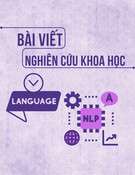


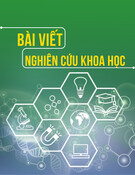
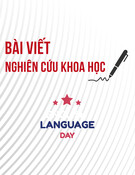

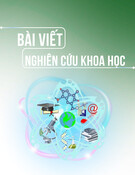

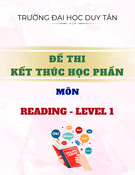
![Đề cương môn Tiếng Anh 1 [Chuẩn Nhất/Mới Nhất]](https://cdn.tailieu.vn/images/document/thumbnail/2025/20251130/cubabep141@gmail.com/135x160/51711764555685.jpg)










![Mẫu thư Tiếng Anh: Tài liệu [Mô tả chi tiết hơn về loại tài liệu hoặc mục đích sử dụng]](https://cdn.tailieu.vn/images/document/thumbnail/2025/20250814/vinhsannguyenphuc@gmail.com/135x160/71321755225259.jpg)
